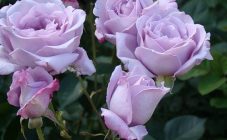Content:
Floribunda rose Aspirin is a variety that first appeared in Germany in 1997. The variety got its name due to the fact that it was bred to the centenary of the beginning of the production of the drug aspirin. Even though now this is not such a popular medicine (in some countries it has been banned altogether), roses are widely used in landscape design. Flowers are used to make floristic compositions and use them in cosmetics.
Biological features
Speaking about the biological characteristics of roses, they mean the height of the stem, size, shape, color of the buds, flowering time, smell, the ability to tolerate temperature fluctuations normally, and susceptibility to disease. It is these factors that are decisive and determine the demand for flowers.
Aspirin Rose is a richly blooming rose, but is often referred to as a climbing miniature or ground cover species. This variety is very profitable to grow, Aspirin Rose will ideally fit into a small cozy garden and a large landscape composition.
The average diameter of the bud is 8 cm. When flowering begins, the middle of the flower is painted in a pale pink color; if the air is cool, the shade becomes more saturated. As the petals unfold, they become snow-white. Each cluster can be studded with 10 to 15 buds, making the shrub almost completely adorned with shining white flowers.
Each bud has more than 50 petals, the structure of which may vary. The variety is notable for the fact that the petals from the buds begin to fall off even before they lose their color or become covered with spots, so the plant looks very neat.
The Aspirin Rose bush blooms profusely, and it happens in all buds at the same time. There is a constant change of crumbling inflorescences to new, lush, beautiful and fresh flowers. The variety belongs to the category of plants that can bloom repeatedly and for a very long time - about 5 months. The budding period begins in June and continues until the October cold weather.
Resistance to frost and disease
The Aspirin Rose shrub is able to withstand very low temperatures - down to -29 ° C. However, it is still recommended to play it safe by covering the bushes with something warm to the frost.
The variety is not very susceptible to diseases that tend to infect roses, however, black spot or powdery mildew can still sometimes infect a plant if the optimal growing conditions are violated or the period of growth and development of the rose was accompanied by negative conditions and environmental influences.
Landing
The most successful landing place is some kind of hill. Then, in the spring, melt water will quickly move away from the bush. In areas where winters are warm, it is necessary to plant in autumn, and where frosty - in spring.
In case of planting in the fall, it is necessary to shorten the seedlings by about 15 cm. However, the main pruning is carried out in the spring. When the plant is planted in springtime, the shoots are shortened more.It is necessary to leave 2-3 buds for a strong seedling, for a weak one, 1-2 will be enough. Before planting a plant in open ground, you need to take care of the readiness of the soil.
Care features
For the ground cover rose Aspirin, it is necessary to regularly look after: water, apply top dressing, cut off in time.
Watering
It is best to water either early in the morning or late in the evening so that less moisture evaporates when exposed to direct sunlight. The plant is irrigated every time the surface of the soil approximately 4 cm deep has dried out. Therefore, the watering frequency can be set independently.
Top dressing
Abundant flowering of roses is possible only if you regularly fertilize the bush. During the growing season, this must be done at least 4 times.
For the first time, the soil should be fertilized in early spring, when the first leaves are formed on the bush. For this purpose, you can use agents such as Cytovit, Agricola and others intended for flowering plants.
Re-feeding - one month after the first. You can use the same means as for the primary make-up.
The third time the plant is fed at the end of the first wave of flowering. This stimulates the bush to bloom again. There is no need to change the product.
For the fourth time, it is recommended to feed the plant in the fall, after the flowering period has ended and the bush is preparing for wintering. In contrast to the first three cases, it is better to use fertilizers containing potassium. This will promote the ripening of the shoots.
Pruning
This variety of roses must be pruned twice throughout the year: in spring and autumn. In the spring, shoots are cut that have suffered in winter due to cold weather or wind. Such shoots need to be cut at the root.
The purpose of autumn pruning is to remove fungus-infected shoots, to reduce the length of bushes that have grown too large. The ends of the shoots must be shortened by 10-20 cm. In an area characterized by severe frosts and cold weather, it is important to cover the roses.
Landscape and design
Rose Aspirin looks great when decorating gardens. It is a common practice to plant bushes close to each other in groups, which allows you to enjoy an amazing green leafy cover during the flowering period, which over time will adorn the snow-white flowering.
This variety of weeping shape, milky color is really universal, because it is planted in flower beds, in gardens, and rocky surfaces of the earth are decorated. The variety will decorate alleys and arches, it is applicable in design solutions. Floribunda looks very unusual and beautiful on lawns in parks and private territories in the form of chic boles. Looks harmoniously with many other plants.
Advantages and disadvantages of the variety
Due to its unique qualities, the rose has a number of advantages:
- flowers can change the color of the petals as it gets colder;
- differs in winter hardiness;
- flowers of this variety can be grown in the form of a miniature rose, floribunda, compact shrub or a stately trunk.
There is also a drawback - difficult care, since it belongs to the ground cover species.
These roses are beautiful, they will decorate any place, but they require special attention to themselves. In order for the plant to feel comfortable and able to bloom again, before buying it is necessary to study the description of the variety and follow all the rules for caring for it.

















